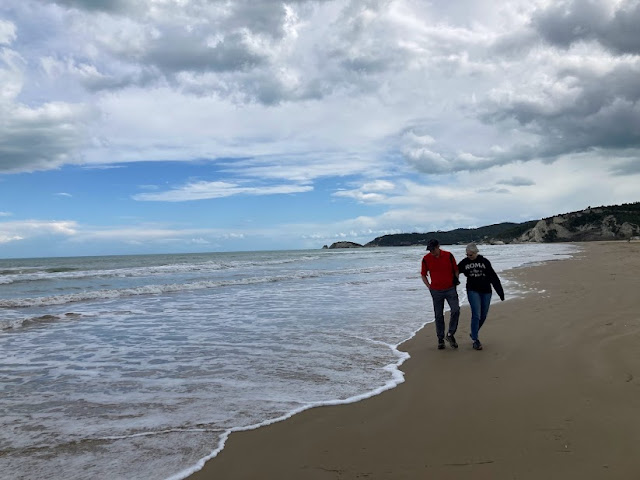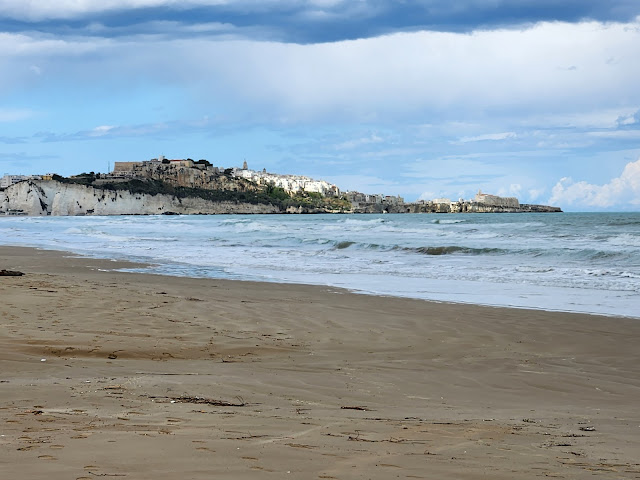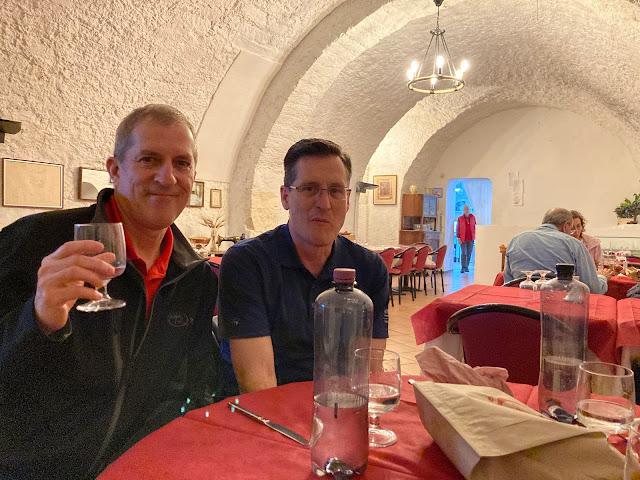Not gonna lie but I was a bit nervous going into this day. We got off to a flying start, up and at 'em, showered, packs on our back and caught a taxi to the train station. As we waited for our train to arrive, we snarfed down our chocolate and cream-filled cornetti (croissants) purchased the day before at the Casa del Panne.
And what we didn't finish (see photo below) on this morning and throughout our trip, Ron volunteered to take and eat and run or eat and walk or just plan eat. In fact, he did it again and again and again, day after day. The thing is, he's basically the same height and weight as me -kinda bean pole like- but has an innate ability to seemingly eat all day and yet never get full. How does one acquire such a skill? I honestly don't know how he did it? And doing so in Italy? There can't be a better place on earth to possess such a skill. I was envious and yet in awe. New life goal = #belikeRon
 |
One thing we learned is, despite the passage of four decades, some things never change in Italy. When Ron and I were missionary companions, public transportation strikes seemed to happen all the time. They were unannounced and bothersome. In fact, one time while living in Catania, the bus drivers went on strike. That didn't stop us so we walked to the far size of our zone on the other side of the city to do some missionary work. It was a steamy, hot, overly humid day. And to make things worse, there was an ashfall from Mount Etna, an active volcano spewing lava and belching out ash high above the city. We were beat but rather than walk home for lunch, we decided to make a larger loop downtown to the mission office. When we arrived at the front door, we were a sweaty, muddy mess. Sister Turner, wife of the mission president, was like, "Oh my goodness!" I wish I had a picture of that. We went inside and wiped ourselves down pretty good. I don't totally remember but I'm guessing we took off our shirts and ran them under the water before wringing them out and restoring some whiteness to them.
The reason I hearken back to that memory is we were greeted this day with another such random public transportation strike but this one was nationwide across Italy. That meant our scheduled and paid-for train ride south could be cancelled. We waited, watched the information boards and hoped for the best. While some other scheduled routes were cancelled, ours was not. Whew!
Once on board, we settled into chairs that faced each other for the three-hour ride to Foggia in the Puglia region. When Ron and I rode trains back in the day, especially the really old ones in Sicily, well, I equate them to washing machines on wheels. They were army green in color, maybe because they dated back to World War II or earlier, and would rock back and forth in a cadenced or rhythmic, yet noisy manner as they rolled down the tracks. These 2023 trains were most definitely not your 1980 trains. According to the on-board monitor, when I looked at it anyway, our bullet train was humming along at 250 kilometers per hour or about 155 miles an hour. We were booking! And it was a smooth, scenic ride with olive groves as far as the eye could see.
For the four of us, this was our first real time to just relax, chat and catch up. Though we'd been together a day and a half, we were always coming or going, seeing and experiencing or eating. Now we had the chance to sit and talk kids and grandkids as we played cards and shared some missionary tales of years long since past. It was so wonderfully nostalgic. And to share those throwback Italian stories as we zipped across Italy was amazing.
We arrived in Foggia with no issues. As we lined up to get off the train, a woman leaned into her monstrous suitcase on wheels to build momentum to get rolling down the aisle.
"Is there a little boy in there?" I cracked.
"Where?" she asked.
"In that thing. It's huge," I said.
"It's heavy too," she laughed as she offered it to me to lift off the ground. She was right. It was heavy, certainly heavy enough to have a kid in it. Dang, I felt the language was slowly coming back and that made me really happy.
After getting off the train, we looked for a bathroom in the station and found one. It had what I guess you'd call a security glass door over its entrance. To crack the code, you had to put a one dollar Euro coin in the slot. You got it, it was "pay to poop," the first of several we saw across Italy.
 |
| If you gotta poop, you gotta pay |
The plan was to walk to the rental car agency to pick up a small four-seater I'd previously reserved to continue on our trip. We arrived at the office with nobody inside. I pulled up my reservation information, made a call and was told our car would arrive shortly. Sure enough, it wasn't five minutes until I was inside, filling out the final paperwork and we were on our way.
Okay, here's the "nervous" part I referenced. Driving in Italy is not even close to driving in America, where signs and stoplights are almost meticulously followed. In Italy, they're more like suggestions. At least that's how Italians, who are extremely offensive drivers, seem to use them. They don't check blind spots. They don't obey the rules of the road. In fact, I think they make up their own rules. They dart in and out of traffic, lay on the horn early and often, make faces and hold their hands up as they expressively bark out demands and accusations. Add to that the unpredictable Vespas scooters that zigged in and out of traffic like bothered water bugs after you chuck a rock into a pond. They would even swerve into oncoming traffic or jump up onto sidewalks.
The ironic thing is, Italy is where I actually learned to drive a stick shift in the first place. As a young missionary who had barely turned 20 years of age and had just received a new leadership assignment, we had a little, four-door Fiat assigned for our use. We didn't drive it all the time but I did have experience driving the streets of this driver-crazed nation, albeit from 40 years earlier.
To be honest, a stick shift on is no big deal at all. My first two trucks were sticks, Lori's car she brought into the marriage was a stick and I'd driven cars on the job when I worked construction that were stick shift, plus I'd driven stick shift tractors and forklifts over the years. Although I reserved a Fiat, what showed up was a four-door DR, also made in Italy but supposedly based on Chinese cars using parts from a Chinese carmaker.Now, here I was climbing behind the wheel again and, just like in the mid-1980s, hoping to avoid crashing into anyone and having anyone crash into me. All I needed was good fortune and support to get out of town and that's exactly what I got thanks to in-car navigation skills from my fellow travelers. "Turn left, turn right, go here, go there" and we were out of Foggia and traversing roads less traveled as we headed northeast toward the Adriatic Sea and Gargano National Park.
The DR was fun to drive. The route was pretty too, with long straightaways and tunnels giving way to windy coastlines. Thirty-five minutes into the drive, our stomachs had a two-word message for us as we could see water on the horizon: feed us! So, we pulled into the town of Manfredonia to look for a place to satisfy our hunger. Across the street we saw L'Angolo dei Sapori (The Corner of Flavors). The second we walked in, we knew this was a classic Italian bakery-eatery. Why? We could see it, we could smell it and we could taste those aromas before we got our lunch in our hands. This was the Italy I remembered from years ago. As young missionaries we never, ever ate at sit-down restaurants because we could never afford to do so. Instead, we ate at small Ma and Pa, salt-of-the-earth shops just like this one. For lunch, I went with salami and mozzarella on fresh-baked Italian bread, a Fanta aranciata and blood oranges bought from a fruit stand just down the way. |
| (left to right) Ron, my panino, April, Lori & me |
 |
| Mm, mm, excellent! |
We wandered over to a small park right on the Adriatic Sea, sat down and ate. It was a breezy but beautiful day. When we finished eating, Lori checked her first box of "sticking a toe in each of the three oceans that surround Italy." Off came her shoes and into the water she went. Yes indeed, she was in her happy place.
Neither Ron or I had visited Gargano National Park back in our missionary days. I stumbled across it while doing some pre-trip reconnaissance and floated it as a possible destination. The online imagery was impressive but the real thing was downright beautiful, even stunning. We found a narrow roadway pull-out to get a better look at some of the rock outcroppings. I found myself with a set of "if only" thoughts running through my head. If only it was warmer and sunny. If only we had all day to climb on the rocks. If only we had our paddleboards with us. If only we could dive into the deep blue waters. If only we could paddle back into the caves.
While looking for seashells, I made a most interesting find - an empty box of cigarettes with bold white letters that stated "Smoking causes heart attacks." But what got me was the accompanying image of a man with his shirt off, laying on his back in obvious distress with a defibrillator paddle on his chest. That's a pretty strong message but, unfortunately, we saw a lot of people including many teenagers that it didn't apparently scare.
We continued our drive along the coast and eventually stopped at a campground/RV park, used the restrooms and then walked out to the beach. It was still cool and breezy but hey, at least it wasn't raining.
As quickly as the rains came, they left and we continued our trek until we found ourselves in front of what's called Chianca Amara (bitter stone) just outside the Vieste Cathedral, the very spot where a real-life and extremely graphic tragedy took place centuries earlier. In 1556, the Turkish pirate Dragut Rais landed in the harbor just outside Vieste with his 70-ship fleet, which bombarded the city and Castle of Vieste with 970 cannon balls. Locals took up arms. They held off the pirates for six days but on the seventh day Dragut reneged on a promise to allow the citizens to leave the town in exchange for their gold and silver. Instead, the pirates sacked the city, attacked the women and captured men to sell as slaves. The pirates escorted the children, elderly and the men and women would could not be sold to Chianca Amara where they were beheaded. Yikes!
 |
| Chianca Amara |
We made our way to the edge of town and walked along a stone pathway overlooking the Adriatic Sea on Punta San Francesco, a small peninsula on which the medieval district stands. The focal point is the Church of St. Francis, framed below by a nice post-shower rainbow, built sometime prior to 1289 and named after St. Francis of Assisi who founded a convent in Gargano.
We were getting hungry but as we'd already learned, dinnertime for Americans is not the same as dinnertime for Italians. We had some time to kill so we made our way back to the car and drove 15 miles to our night time destination of Peschici, another small seaside town in Gargano National Park.
After finding and settling in at our Airbnb, we went in search of dinner and found a great landing spot in the Ristorante da Peppino, an older man (wearing red in the background of second photo below) who had various roles in the restaurant since 1961. The menus were in Italian so we relied on Ron to play the role of translator. After all, unlike me, he had prepared much better to be able to speak and understand the language prior to our trip. (Atta boy & thanks, Ron!)
We all ordered pretty much the same thing. The four-course meal off the farmer's menu began with homemade bruschetta. As a kid, I would turn my nose up to dishes that featured chunks of tomatoes. Maybe that's because those tomatoes weren't like these tomatoes. They were tastily seasoned and complimented nicely by the crunchy bread base beneath but the real showstopper for me were the pickled zucchini. Wow, so good! That being said, not even being on Italian soil was enough motivation to for me eat the handful of accompanying olives on my plate. I tried one but they were and remain nasty.
The second course was my favorite because it was pasta. I mean, how can you go wrong with pasta? I went with fresh orecchiette (tiny ears) with fresh tomatoes and ricotta cheese. Yeah, now we're getting somewhere! I could not get enough of it. One thing that stands out is the way Italians prepare their pasta. I noticed it the first night in Rome. They don't cook their pasta until it becomes soft all the way through. Instead, they leave a little bit of chew on it, so to speak. It's not like the way Americans cook their pasta until you don't really need your teeth to chew it up.
The third course was oven-baked eggplant. Now this, too, is something I probably wouldn't order at home. It was finely seasoned and the accompanying small orange tomatoes were a nice, acidic compliment.
Lastly, a fresh salad with lettuce and tomatoes was put in front of me. And let's not forget that a basket of that awesome, chewy homemade Italian bread accompanied the meal. We had one or two helpings with our meals and I got another for the road.
While we're talking bread, let me take a moment to climb up on my personal podium to dispel something I see again and again at "Italian" restaurants in the United States. So many of them serve bread (that's usually not like authentic Italian bread but that's another story for another day), however my main point is it's served overly seasoned and often with liberal helpings of pesto and/or oil. That's just not a thing in Italy. Or at least it isn't a thing in the regions of Rome, Naples, Puglia or Sicily where we ate. I also never saw that when I ate with Italians in their homes 40 years ago as a missionary in the Puglia or Sicily. Maybe that's how they do it in northern Italy. Still, when preaching the gospel of Italian bread, take it straight up.
 |
| The "bread of life" #preachit |





































No comments:
Post a Comment